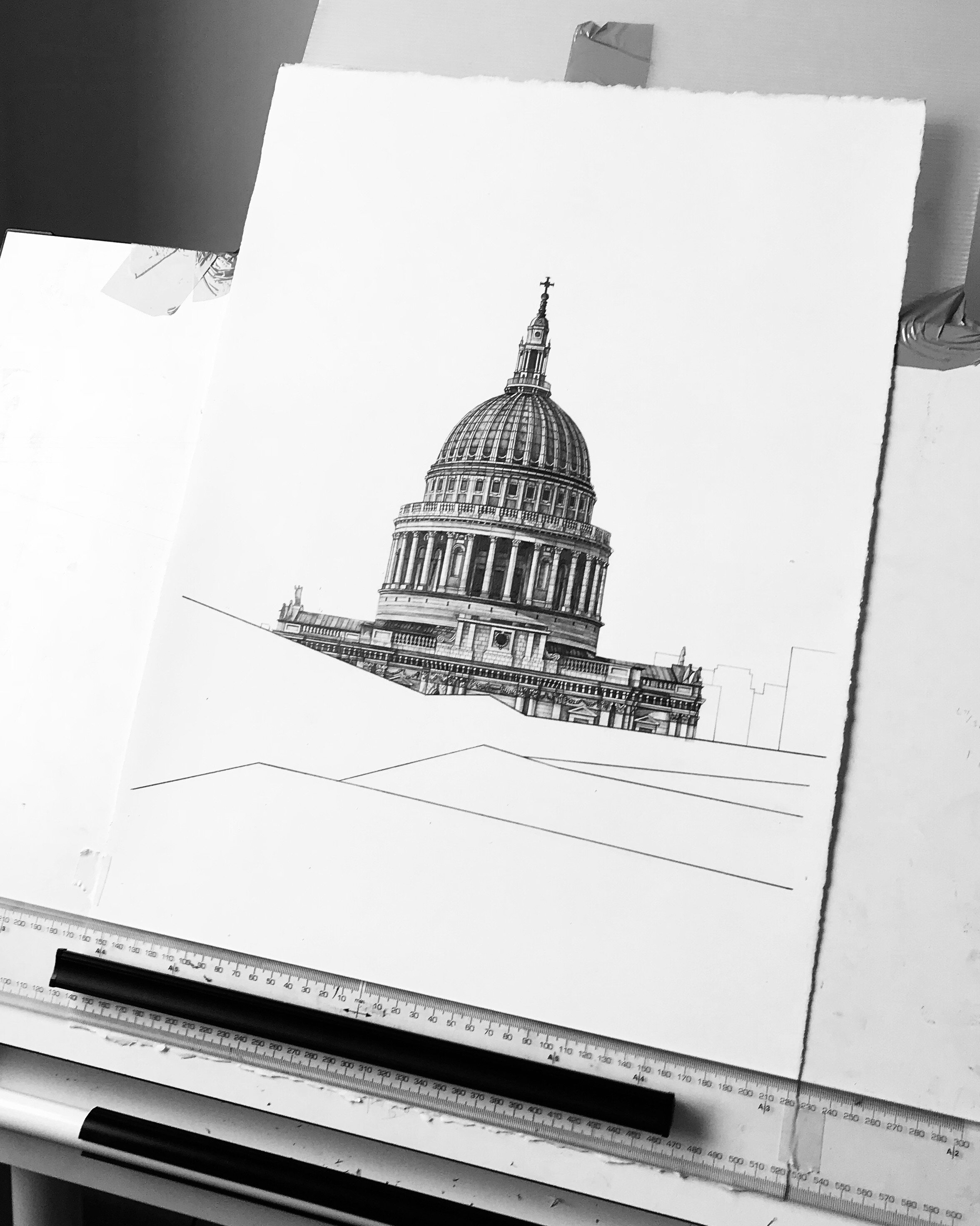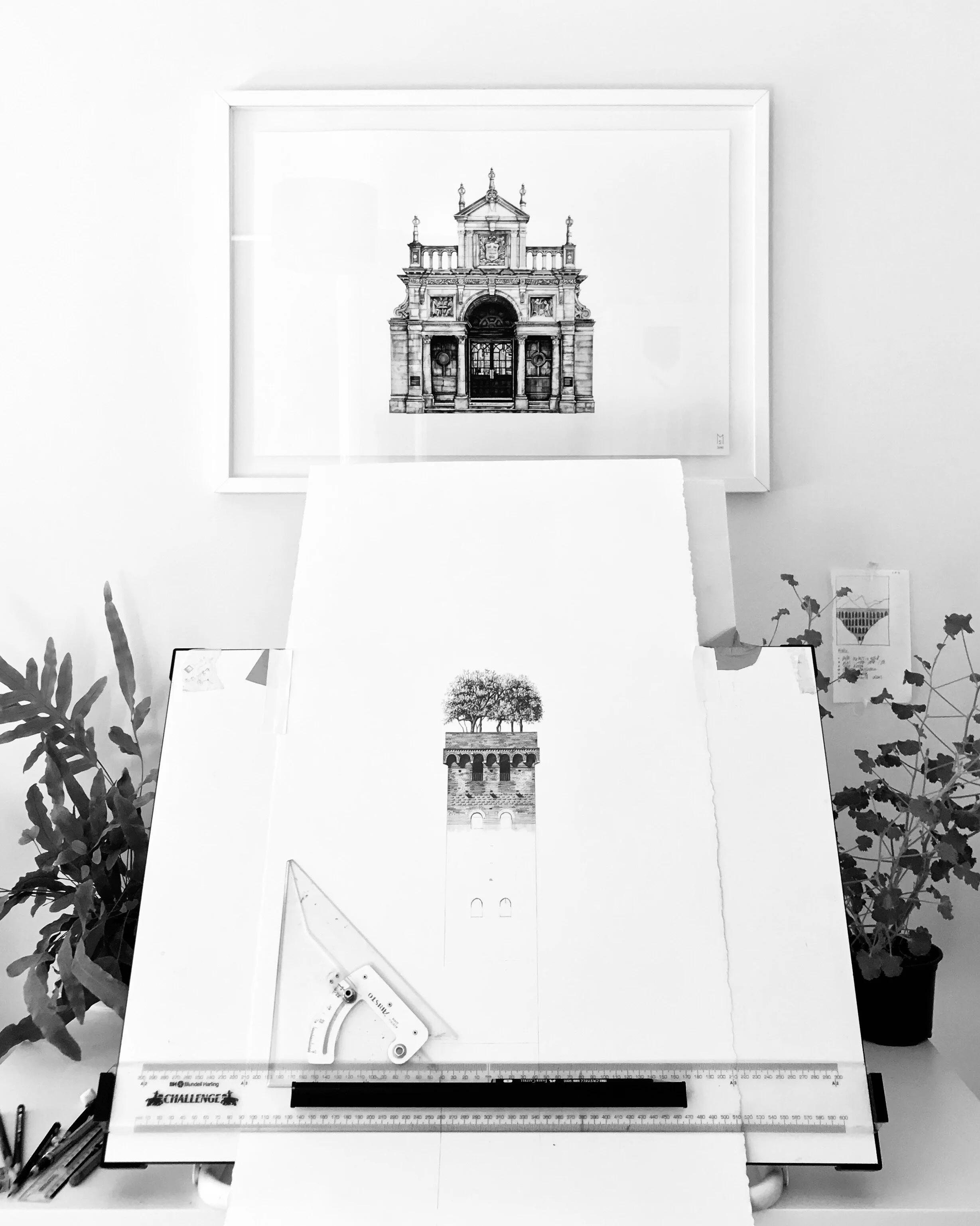INTERVIEWS
In February 2025 I took part in a talk series with the Institute of Classical Architecture and Art which will be uploaded on their website later this spring.
In 2025 I did a video interview with Artfully Crafted on YouTube.
Short documentary video made in 2019 showing the process of me travelling to Oxford, photographing the Radcliffe Camera, learning about the history of the building, then drawing the building back home. The finished video can be seen here on Youtube.
I was interviewed when doing The Other Art Fair in 2017 for Saatchi Art Youtube channel.
Q&A with Minty
I get lots of lovely emails every week from people doing their GCSEs/A-levels/Architecture degrees who want some more information to write up in their art projects. I have tried to answer some of the regularly occurring questions. So here they are:
Is Minty your real name?
Firstly let's sort out this question! So my full name is actually Araminta but I have always been known as Minty for short. And no...unfortunately I am no relation to the supermarket!
How old are you?
I was born in 1991.
How would you describe your artwork?
I create highly detailed pencil drawings of architecture I see in the UK and abroad. Sometimes I draw the building out of its context, putting it in isolation in the centre of the page. Other times I choose to show the street view towards a building, keeping a simplistic abstract outline of the context.
What drew you to architecture?
I always loved drawing and art as a child and as I grew up I became interested in historic buildings. I’d make scrap books of places and buildings ripped out of magazines. I loved drawing maps and plans of my house and garden and enjoyed rearranging the furniture in my bedroom on the plans I drew. This then moved onto designing hutches for my chickens which got quite elaborate! When it came to deciding what I wanted to study at university I put together this love of making things, designing, drawing and historic architecture and it lead me to architecture. It doesn’t surprise me though that now rather than designing new buildings I’m drawing old buildings as it was historic architecture that I was first interested in.
When did you first decide to pursue a career as an artist?
I had been selling my artwork and doing commissions from the age of fourteen but I never considered working full-time as an artist. I continued to sell my work throughout university and even whilst working in an architectural practice, but I never thought about a career as an artist. It wasn’t until I had quit my job and had absolutely no plan what to do next that I thought I had nothing to lose, so I decided to give it a go. I had by this point been working in London for a couple of years and thought that whatever I did next I wanted to be something that really excited me and I could see myself doing for a long time.
What does making art mean to you?
When I make art, I am trying to make the viewer look differently at the urban landscape around them. I take one building at a time and focus on the detail with the hope of showing people the incredible beauty surrounding them in their cities.
How does material/medium inform your practice?
Working with graphite pencil allows me to work very precisely and in great detail. If I were to try and recreate my picture with paint I think I would find it really hard to work to the same level of detail. Also I really enjoy drawing just in black and white as this forces me to concentrate on the light and shadows in my work. When colour is removed from a picture the tonal contrast created by light is really accentuated.
What inspired your unique style of drawing a street view?
This style of depicting a street view with just the outline of the contextual buildings and only one focal building drawn in high detail was inspired by my time at University studying architecture. At University I loved making models and often this involved making a large site model out of white card and the building I was designing I would create in much greater detail using a different material. Therefore when I photographed the site model with my new inserted building this new building would stand out from the rest of the surrounding white card buildings. In my projects at University I was really interested in the idea of buildings being carefully positioned at the end of a road so they acted like a beacon drawing people along the path towards them. I think because these ideas of city vistas and planned views really interested me as an architecture student it meant I was always on the look out for these views towards buildings when I was exploring a city and eventually lead to me wanting to draw these views.
What is the most memorable piece of art you have produced?
Probably the most memorable piece is the facade of the Basilica of San Petronio in Bologna. Firstly because it is the longest piece I have ever worked on but secondly because it was the first piece in which I deliberately cropped the piece so instead of showing the whole form of the Basilica I focused on the detail. By looking at the facade in this way the viewer is forced to notice the difference between the textured patterned brickwork and the smooth marble. If you are given the whole building it is very easy to identify it from it’s shape so I like that this piece takes a little longer to recognise and is most often done so by people who know it really well.
Do you have a favourite architectural period or architect?
I don’t have a favourite period of architecture. If anything I actually really like the coming together of different styles and time periods in buildings and cities. It’s beautiful to see the coming together of different additions and alterations in a building which shows the passage of time. But if I had to pick I’d probably lean towards Renaissance architecture.
What’s the last exhibition you saw that made an impact on you?
Last year I heard about an artist called Thomas Jones who travelled to Italy and made really beautiful paintings of everyday scenes so I went to the National Gallery to track down some of these pictures. These pictures were painted in the 18th century and show an insight into the urban landscape in Italy at this time. My favourite piece shows a wall in Naples with one window from a front on perspective, and the wall is crumbling and has washing hanging out and it’s just a really simple minimalist composition. Lots of the pictures I draw are of grand expensive buildings and seeing these pictures reminds me that you can make beautiful artwork from any style of architecture.
Has any place or environment affected your work?
When working on a new series of drawings of Venice I initially thought to draw the canal view in the same way I would treat a street view by outlining the context and only drawing one building in the picture. However when it came to drawing Venice the canals are such a defining element of what makes Venice so unique. So I tried a new idea of drawing the reflections in the water which gives a hint of the contextual buildings.
Your drawings are so intricate, yet you balance negative space so effectively which makes them almost minimal. Can you tell me more about your style?
I guess this style of depicting a street view came about because I wanted to focus the viewers eye on one particular building to appreciate all the detail and complexities in that one facade. To do this, I chose to leave the context blank and remove all the clutter and distractions from shop signs, advertisements, bus stops and cars in order to look solely at the architecture.
I wonder if this way of looking at a street might have come from studying architecture where I spent a lot of time model making. Often for a project I would make a site model with all the existing buildings and landscape made in a monochrome coloured card and the new proposed building made from another material which would make it stand out from its surrounding. In this way you are showing the building in context so you can understand the height of the neighbouring buildings and the street width but focusing predominantly on just one building. This method of representing a building or idea might have influenced how I then chose to draw.

